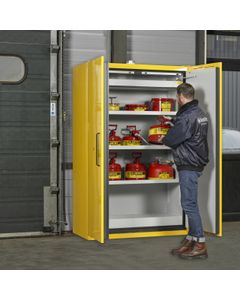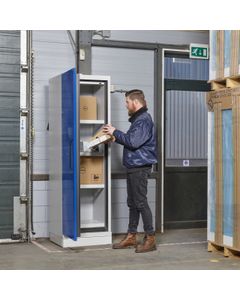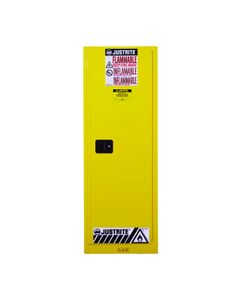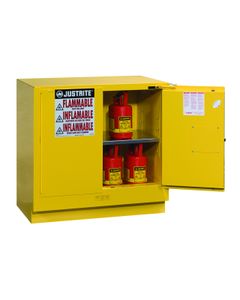Categorie
Armadi di sicurezza per infiammabili
Per proteggere il tuo personale e la tua struttura da un potenziale incendio, gli armadi di sicurezza Justrite offrono una protezione antincendio superiore per lo stoccaggio di liquidi infiammabili, aerosol e altri materiali pericolosi.
Leggi di più

Armadi sicurezza EN 90 Minuti 226-EN Justrite armadio di sicurezza per liquidi infiammabili
Armadi di sicurezza EN per lo stoccaggio di prodotti infiammabili con estrema resistenza al fuoco per 90 minuti.
Disponibile in 2 versioni

EN Lithium Battery Safety Cabinets - 90 Minutes 226-LT Justrite
Armadi di sicurezza EN per un alto livello di sicurezza durante lo stoccaggio e la ricarica delle batterie agli ioni di litio
Disponibile in 3 versioni

Armadi di sicurezza Sure-Grip® EX per fusti verticali 89-VD Justrite Giallo
Deposito verticale conforme a OSHA e NFPA per uno o due fusti da 110 L a 200 L
Disponibile in 3 versioni

Armadi di sicurezza Sure-Grip® EX a due vie 89-PG Justrite armadio di sicurezza per liquidi infiammabili Giallo
Il design ad altezza ridotta consente di riporre materiali infiammabili sui piani dei banchi da lavoro o sopra gli Armadi da 114 L e 170 L
Disponibile in 4 versioni

Armadi di sicurezza Sure-Grip® EX classici 89-CL Justrite armadio per sostanze infiammabili Giallo
Proteggi i lavoratori, riduci i rischi di incendio e migliora la produttività aziendale conservando carburanti e sostanze chimiche infiammabili in armadi di sicurezza conformi alle normative OSHA e NFPA.
Disponibile in 9 versioni

Armadi di sicurezza Sure-Grip® EX classici 89-CL Justrite armadio per sostanze infiammabili Rosso
Proteggi i lavoratori, riduci i rischi di incendio e migliora la produttività aziendale conservando carburanti e sostanze chimiche infiammabili in armadi di sicurezza conformi alle normative OSHA e NFPA.
Disponibile in 1 versioni

Armadi di sicurezza Sure-Grip® EX per montaggio a muro 89-WM Justrite armadio di sicurezza per liquidi infiammabili Giallo
Make the most of usable storage space—hang cabinet above workbench for easy access to work solvents
Disponibile in 2 versioni

Mini armadi di sicurezza 89-MI Justrite armadio di sicurezza per liquidi infiammabili Giallo
Armadietto di dimensioni ridotte per riporre in modo sicuro i materiali infiammabili a portata di mano; facile da spostare
Disponibile in 1 versioni

Armadi di sicurezza Sure-Grip® EX Slimline di larghezza ridotta 89-SL Justrite armadio di sicurezza per liquidi infiammabili Giallo
Permettono di conservare i materiali infiammabili in modo sicuro quando lo spazio sul pavimento è ridotto; possono essere utilizzati per aumentare lo spazio di stoccaggio accanto agli armadi già esistenti
Disponibile in 3 versioni

Armadi di sicurezza Sure-Grip® EX Slimline larghezza ridotta 89001-SL Justrite Giallo
Safely store flammables when floor space is tight or use to expand storage alongside existing cabinets
Disponibile in 3 versioni

Armadi di sicurezza Sure-Grip® EX sottobanco 89-UC Justrite armadio di sicurezza per liquidi infiammabili Giallo
Position under a counter to take advantage of storage space and keep liquids near benchtop work space
Disponibile in 2 versioni

89-AB Justrite Giallo
Fits up to 24 cans in two steel roll-out shelves with easy glide plastic rollers and top guard protection.
Disponibile in 1 versioni
FAQ su Armadi di sicurezza per infiammabili
How fire resistant is your Oily Waste Can?
Justrite Oily Waste Cans (OWC) are manufactured galvanized steel a fire resistant material as required by OSHA 1926.252(e). But there is more to an OWC design than that. The OWC self-closing lid limits the inside of the OWC of the oxygen that is required to support combustion. The self-closing lid guards the contents from sparks or other heat sources. Oily rags can create an exothermic chemical reaction from the polymerization of oil drying in the absence of air. This is a chemical reaction known to start fires. Always store oily rags in an approved OWC.
Why haven’t I heard about this yet?
Laws such as those driving these requirements are typically enforced once the jurisdictional authorities become aware of them. This takes time. Your local jurisdiction may not be fully aware and/or enforce the latest edition of these regulations yet. Best safety practices follow a proactive, rather than reactive, approach to compliant hazardous material storage.
How fire resistant is your Oily Waste Can?
Justrite Oily Waste Cans (OWC) are manufactured galvanized steel a fire resistant material as required by OSHA 1926.252(e). But there is more to an OWC design than that. The OWC self-closing lid limits the inside of the OWC of the oxygen that is required to support combustion. The self-closing lid guards the contents from sparks or other heat sources. Oily rags can create an exothermic chemical reaction from the polymerization of oil drying in the absence of air. This is a chemical reaction known to start fires. Always store oily rags in an approved OWC.
Why haven’t I heard about this yet?
Laws such as those driving these requirements are typically enforced once the jurisdictional authorities become aware of them. This takes time. Your local jurisdiction may not be fully aware and/or enforce the latest edition of these regulations yet. Best safety practices follow a proactive, rather than reactive, approach to compliant hazardous material storage.
Can I store gasoline and oil in the same cabinet?
Yes:
OSHA 29 CFR 1910.106(d)(3)(i&ii):
Design, construction, and capacity of storage cabinets (i) Maximum capacity. Not more than 60 gallons of Class l or Class ll liquids, nor more than 120 gallons of Class lll liquids may be stored in a storage cabinet.
Can I store containers in the sump of a safety cabinet?
Yes. The specifications on the sump only states it be 2-inches deep and watertight. Minimum volume is not addressed. The sump can give a safe visual indication and contain a leak before it becomes a problem, allowing the users to correct the leaking container, and clean up a spill as quickly as possible. There is nothing in writing from OSHA, NFPA, IFC, FM, or UL to limit the use of the sump on a safety cabinet for storage. That is not to say you could not limit its use for storage as an internal safety policy. An official having jurisdiction (State Fire Marshal, Building Inspector Local Fire Chief, etc.) at your site might discourage using the sump for storage. However, there is nothing otherwise to preclude storage in the sump.
What types of chemicals should be stored in these cabinets?
These cabinets are intended to store corrosive solids and liquids, flammable solids, organic peroxide formulations, oxidizer solids and liquids, pyrophoric solids and liquids, toxic or highly toxic solids and liquids, unstable (reactive) solids or liquids, and water-reactive solids or liquids. Always ensure that incompatible materials are stored in separate cabinets, and consult your local code authority for any other items in question.
Does my safety cabinet need to be grounded?
It is necessary to ground a safety cabinet if you are dispensing liquids from container(s) inside the cabinet, and the potential of an ignitable vapor is possible. This is not to preclude one from grounding all cabinets as a best practice. Please see our TechTALK on Safety Cabinet Grounding for further information.
Do I need self-closing cabinet?
Flammable liquid safety cabinets self-close requirement depends on your state's fire code. Hazardous material safety cabinets are required to be self-closed everywhere. As a best practice all safety cabinet should be self-close.
Will my modification void the FM Approval and Justrite warranty to a safety cabinet or safety can?
Modifications to any FM Approved products void the approval of that product and the Justrite warranty. The modification falls outside the evaluation for the approval and FM's quality assurance program. Modifications can make a safety product unsafe.
Can I leave my containers in boxes and store them in a safety cabinet?
This question is asked a lot. There is nothing in writing to preclude you from having boxes, papers, etc., in a safety cabinet, but we discourage it. This is an area of best practice not addressed by the law. The standards to which a cabinet is tested limit the internal temperature from exceeding 325°F (163ºC) for 10 minutes in a fire test. This is a conservative temperature below the auto ignition temperatures of the liquids being stored. It makes sense that packaging, such as boxes, are made of materials with auto ignition temperatures higher than the 325°F (163ºC) too. But, what can be dangerous is if those boxes become soiled with residues of the flammable liquids which in turn give off harmful, ignitable, or hazardous vapors. Additionally, it is important to avoid storing materials and combinations of material that can spontaneously combust and create fire inside the cabinet, like oily rags and incompatible materials.
Our vote is on the side of best practice, safety, and of tidy housekeeping. We have heard of OSHA inspectors frowning on this practice even in the absence of law.
Are safety cabinets required to have their bung plugs installed?
Yes, it is required to keep the bung caps tightly in place, unless venting. Please reference the TechTALK on Safety Cabinet Venting for further information.






